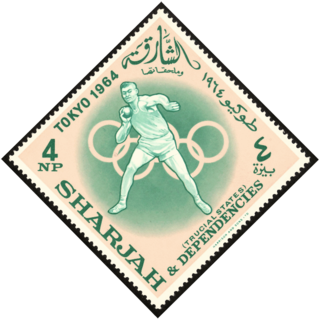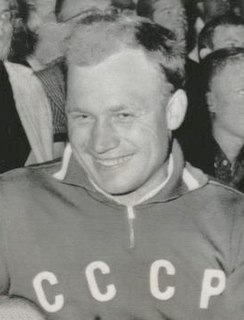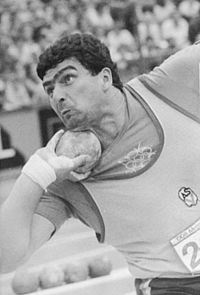
The men's discus throw competition at the 2004 Summer Olympics in Athens was held at the Olympic Stadium on 21–23 August. It was originally planned to hold the discus throw at the Ancient Olympia Stadium, but it was discovered that the field was not large enough to accommodate the range of modern discus throwers, and would have posed a danger to spectators. As such, it was decided to move the discus throw and to hold the shot put at the ancient stadium, despite the fact that the shot put was not contested at the Ancient Olympic Games. Thirty-name athletes from 26 nations competed.

The men's shot put was a track & field athletics event at the 1900 Summer Olympics in Paris. It was held on July 14 and July 15, 1900. 11 shot putters from five nations competed. The event was won by Richard Sheldon of the United States, the nation's second consecutive victory in the men's shot put. Josiah McCracken took silver and Robert Garrett took bronze, completing an American medal sweep.

The men's shot put was one of four men's throwing events on the Athletics at the 1964 Summer Olympics program in Tokyo. It was held on 17 October 1964. 25 athletes from 15 nations entered, with 3 not starting in the qualification round. The maximum number of athletes per nation had been set at 3 since the 1930 Olympic Congress. The event was won by Dallas Long of the United States, the nation's fifth consecutive and 13th overall victory in the men's shot put. His teammate Randy Matson took silver, making 1964 the fifth straight Games the Americans had finished one-two. A second consecutive sweep was prevented when Vilmos Varju of Hungary took third over American Parry O'Brien. Long was the sixth man to win two shot put medals ; Matson would later become the seventh. O'Brien's fourth place finish kept him from being the first man to win four—he had taken gold in 1952 and 1956 and silver in 1960.

The men's hammer throw was one of four men's throwing events on the Athletics at the 1964 Summer Olympics program in Tokyo. It was held on 17 October and 18 October 1964, with the qualification on the first day and the final the next. 25 athletes from 14 nations entered, with 1 not starting in the qualification round. The maximum number of athletes per nation had been set at 3 since the 1930 Olympic Congress. The event was won by Romuald Klim of the Soviet Union, the nation's second consecutive victory in the men's hammer throw. Gyula Zsivótzky of Hungary repeated as silver medalist, the fifth man to win multiple medals in the event. Uwe Beyer took bronze, the first medal for the United Team of Germany and the first medal for any German hammer thrower since 1952.

Udo Beyer is a former East German track and field athlete who competed in the shot put. Beyer has admitted to knowingly taking part in doping while he competed for East Germany. He was a Stasi informer under the codename "Kapitän".

The men's shot put was one of six throwing events on the Athletics at the 1908 Summer Olympics programme in London. The competition was held on July 16, 1908. 25 shot putters from eight nations competed. NOCs could enter up to 12 athletes. The event was won by Ralph Rose, successfully defending his title from 1904 and making it four consecutive Games that the event was won by an American. The two-Games streak of sweeps in 1900 and 1904 ended, however, as Denis Horgan of Great Britain took silver. Johnny Garrels of the United States took bronze. Rose was the second man to win two medals in the shot put ; Wesley Coe nearly was the third as he ended up in 4th place, only 11 centimetres behind Garrels.

The men's shot put was an event at the 1956 Summer Olympics in Melbourne, Australia. The qualifying round and the final both were held on Wednesday November 28, 1956. Fourteen shot putters from ten nations competed. The maximum number of athletes per nation had been set at 3 since the 1930 Olympic Congress.

The men's shot put event was part of the track and field athletics programme at the 1920 Summer Olympics. The competition was held on Tuesday, August 17, 1920, and on Wednesday, August 18, 1920. Twenty shot putters from ten nations competed. No nation had more than 4 athletes, suggesting the limit had been reduced from the 12 maximum in force in 1908 and 1912. The event was won by Ville Pörhölä of Finland, the first time the men's shot put was won by someone not from the United States. Fellow Finn Elmer Niklander took silver. The Americans, who had won all five previous editions of the shot put, including three medal sweeps, settled for bronze by Harry B. Liversedge.
The men's shot put was an event at the 1992 Summer Olympics in Barcelona, Spain. There were 26 participating athletes from 18 nations. The maximum number of athletes per nation had been set at 3 since the 1930 Olympic Congress. The event took place on 31 July 1992. The event was won by Mike Stulce of the United States, the nation's first victory in the men's shot put since 1968. His countryman Jim Doehring took silver. Vyacheslav Lykho of the Unified Team earned bronze, the first medal for a Soviet or former Soviet in the event since 1980.
The men's shot put event at the 1988 Summer Olympics in Seoul, South Korea had an entry list of 21 competitors from 17 nations, with two qualifying groups before the final (12) took place on Friday September 23, 1988. The maximum number of athletes per nation had been set at 3 since the 1930 Olympic Congress. The event was won by Ulf Timmermann of East Germany, the nation's second victory in the men's shot put. Randy Barnes of the United States took silver, the second straight Games that an American finished second. Werner Günthör earned Switzerland's first medal in the event, a bronze.

The men's shot put event was part of the track and field athletics programme at the 1924 Summer Olympics. The competition was held on Tuesday, July 8, 1924. 28 shot putters from 15 nations competed. The maximum number of athletes per nation was 4. The event was won by Bud Houser of the United States, the nation's sixth victory in the men's shot put. Glenn Hartranft took silver and Ralph Hills took bronze to complete the Americans' fourth medal sweep in the event.
The men's shot put event at the 1980 Summer Olympics in Moscow, Soviet Union had an entry list of 16 competitors from 11 nations. The maximum number of athletes per nation had been set at 3 since the 1930 Olympic Congress. The final was held on Wednesday 30 July 1980, with the qualifying round staged two days earlier in the Lenin Stadium. The top twelve and ties, and all those reaching 19.60 metres advanced to the final. The event was won by Vladimir Kiselyov of the Soviet Union, the nation's first victory in the men's shot put. The Soviet Union became only the third nation to reach the podium in consecutive Games in the event, as East Germany became the second to reach a three-Games streak on the podium as Udo Beyer took bronze. Beyer and Aleksandr Baryshnikov became the ninth and tenth men to win multiple medals in the shot put.
The men's shot put event at the 1984 Summer Olympics in Los Angeles, United States had an entry list of 19 competitors from 13 nations. The maximum number of athletes per nation had been set at 3 since the 1930 Olympic Congress. The final was held on August 11, 1984. The event was won by Alessandro Andrei of Italy, the nation's first medal in the men's shot put. Michael Carter and Dave Laut of the United States took silver and bronze, respectively, putting Americans back on the podium for the first time since 1972.

The men's shot put event was part of the track and field athletics programme at the 1928 Summer Olympics. The competition was held on Sunday, 29 July 1928. Twenty-two shot putters from 14 nations competed. The maximum number of athletes per nation was 4. The event was won by Johnny Kuck of the United States, the nation's second consecutive, and seventh overall, victory in the men's shot put. Kuck set a new world record. Future film star Bruce Bennett, then still using his birth name Herman Brix, took silver. Emil Hirschfeld won Germany's first shot put medal with bronze.

The men's shot put event was part of the track and field athletics programme at the 1936 Summer Olympics. The competition was held on 2 August 1936. Twenty-two athletes from 14 nations competed. The maximum number of athletes per nation had been set at 3 since the 1930 Olympic Congress. The final was won by Hans Woellke of Germany. It was Germany's first victory in the men's shot put, and first medal since bronze in 1928. Germany also received bronze in 1936, with Gerhard Stöck finishing third. Between the two Germans was Sulo Bärlund of Finland with silver, the nation's first medal in the event since gold in 1920. For the first time, the United States won no medals in the men's shot put, with the three Americans finishing 4th, 5th, and 6th.

The men's shot put throwing event at the 1960 Olympic Games took place on August 31. Twenty-four athletes from 16 nations competed. The maximum number of athletes per nation had been set at 3 since the 1930 Olympic Congress. The event was won by Bill Nieder of the United States, the nation's fourth consecutive and 12th overall victory in the men's shot put. Parry O'Brien and Dallas Long took silver and bronze, giving the American team its sixth medal sweep in the event. O'Brien, who had won gold in 1952 and 1956, matched Ralph Rose in coming just shy of a third gold medal. The two remain, through the 2016 Games, the only men to win three shot put medals. Nieder was the fifth man to win two medals.

The men's shot put event was part of the track and field athletics programme at the 1952 Summer Olympics in Helsinki, Finland. Twenty athletes from 14 nations competed. The maximum number of athletes per nation had been set at 3 since the 1930 Olympic Congress. The competition was held on 21 July at Helsinki Olympic Stadium. The finals were swept by the United States, with Americans Parry O'Brien taking the gold medal, Darrow Hooper earning silver and Jim Fuchs receiving his second consecutive bronze medal in the event. It was the 10th victory for an American in the event, and the fifth medal sweep for the United States. Fuchs was the third man to win multiple medals in the shot put.

The men's shot put field event at the 1972 Olympic Games took place on September 8 & 9. Twenty-nine athletes from 19 nations competed. The maximum number of athletes per nation had been set at 3 since the 1930 Olympic Congress.

The men's shot put competition at the 1968 Summer Olympics in Mexico City, Mexico took place on October 13–14. Nineteen athletes from 14 nations competed. The maximum number of athletes per nation had been set at 3 since the 1930 Olympic Congress. The event was wo by Randy Matson of the United States, the nation's sixth consecutive and 14th overall victory in the men's shot put. His teammate George Woods took silver, making 1968 the sixth straight Games the Americans had finished one-two. Matson was the seventh man to win two medals in the event ; Woods would become the eighth in 1972. Eduard Gushchin took bronze, the Soviet Union's first men's shot put medal.

Jaroslav Brabec was a Czech track and field athlete who competed in the shot put. He twice represented Czechoslovakia at the Summer Olympics. He was a three-time participant at the European Athletics Championships and a three-time medallist at the European Athletics Indoor Championships, being the champion at the 1973 edition.
















